Written by: Rik
Date posted: May 29, 2006
Anyone know of any decent games magazines? Recent in-depth research conducted by FFG staff (okay, then, yours truly idly wasting a few minutes in a train station branch of WH Smiths) has led me to believe that the cupboard is pretty bare at the moment. One the one hand you have the likes of Edge: pompous, console-oriented and filled with articles and reviews written in the third person to give them a little extra “cool”. On the other, you have the rest: overpriced tat, filled with moronic, poorly-written drivel that fails to inform or entertain. Actually, the same could be said of a lot of games journalism down the years, with the drudgery of the news-previews-reviews-letters format proving difficult to break. In the UK, however, one magazine managed to do so throughout the late 1990s – standing head and shoulders above the rest thanks to a combination of original design, well-written reviews and features and off-the-wall humour. Its name was PC Zone. Stoo and I were both big fans, so be warned – while it stops short of fawning worship (I hope), this is a tribute.
THIS IS AN ACTUAL IN-GAME SCREENSHOT!
When Zone was launched back in 1993, it was pitched as the first PC magazine to focus purely on gaming, and at first glance it seemed like quite a foolhardy venture: CD-ROM was in its infancy, most PC games were also available on the more reasonably-priced Amiga, and they were generally seen as the preserve of greasy IT engineers and teenagers whose dads let them play games on their machine to avoid having to buy them a Megadrive. Tellingly, though, the first Zone cover game was X-Wing – the original must-have, PC exclusive title – and the debut issue also featured a review of Ultima Underworld. Though it remained bulky, overpriced and impractical, the raw processing power offered by the platform made PC gaming an increasingly viable option for developers.
Zone soon established a reputation for offering something a little bit different, not only in being the first magazine to approach the PC as a gaming machine, but also for its well written, humorous reviews, and its willingness as a publication to treat its readers like adults. Admittedly, given the cost of owning and running a PC, most of its readers were adults – but a generation of teenagers soon latched onto the fact that here was a magazine which wouldn’t patronise them. Despite wearing grumpy and occasionally disturbing facial expressions whenever photographed, the Zone team came across in writing as fairly normal people who just happened to enjoy playing games, rather than self-styled gaming “experts” delivering their informed judgement on the latest releases. Even if the game itself wasn’t that interesting, the review still could be; instead of sticking to the tried-and-tested formula (describe the graphics and sound, tell ’em what it’s about, then if it’s any good), Zone writers engaged the reader with new and original approaches, often making reference to (gasp) non-gaming matters along the way.
HE’S AFRAID OF…CHIVES
Each reviewer had a unique style. Many chose a humorous, down-to-earth approach, employing dry and occasionally bizarre humour, but others were more memorably eccentric. In particular, Zone‘s Duncan Macdonald often went off the beaten track in the hope of entertaining the reader in spite of being lumbered with a particularly dull game. Frequently presenting reviews in the form of a conversation between two or more imaginary people, sometimes only mentioning the game itself in passing, his writing was never dull, but then it wasn’t necessarily everyone’s cup of tea, either. Macdonald also wrote a weekly column in the guise of “Mr Cursor”, a man so terrified by the world of computers he sometimes didn’t even bother to talk about them, which for a brief time polarised opinion among the magazine’s readers – with the silent majority finding the column worthy of a chuckle now and again, but a noticeable hardcore of Cursor-haters also frequently airing their opinions on the magazine’s letters page. After furnishing Zone with another one of his comic creations, Colin Culk, Macdonald eventually signed off for good – and hasn’t been seen or heard of since.
YOU WILL BE MISSED BY ONE, MAYBE TWO, PEOPLE
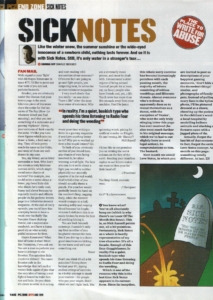
The last ever Sick Notes. “You could write a series about a bitter, pig-faced little shit who thinks he’s really cool, funny and clever because he regularly insults and offends people via his pathetic letters page in a (otherwise decent) magazine.”
Another slightly controversial figure in the PC Zone history books is now widely heralded as a comic genius for his weekly column in the Saturday Guardian, but when Charlie Brooker started on the magazine he was more well-known for his occasional cartoons than he was for his writing. However, through a combination of the two, he quickly became a cult figure, and was eventually was rewarded with his own column. Like Mr Cursor, Brooker’s creation, Sick Notes, was to be found on the last page of the magazine, didn’t always focus on the world of PC gaming, and it, too, attracted criticism from Zone‘s readership. Essentially a letters page, early editions featured Brooker heartily mocking a few moronic letters originally intended for the main postbag, but, inevitably, angry correspondence directed at CB himself soon flooded in. While this was almost certainly the original intention, it quickly became apparent that it wasn’t just the moronic illiterates who had a problem with the whole Sick Notes concept, and after receiving increasingly well-written letters from angry readers, Brooker called it a day, gamely printing a particularly stinging diatribe in full before admitting the whole thing had got out of hand. Aside from the Sick Notes fiasco, other achievements of note included being the only Zone writer to have his picture featured on the front cover (for a feature testing the patience of technical helpline staff) and being responsible for the magazine being pulled from the shelves (his violent “Cruelty Zoo” cartoon was the source of controversy). Of course, he also wrote entertaining reviews and articles, mixing semi-relevant facts about what he was writing about with often-irrelevant and acerbic social commentary – the same combination that makes Screen Burn so popular with Grauniad readers.
QUAKE POUR HOMMES
Though in the early days Zone did little to intentionally court controversy, swear words were used liberally in articles and the writing was generally pitched at people who were old enough to drink and do other “grown-up” stuff. Inevitably, there was the occasional letter from an angry parent wanting to know why this kind of filth was being peddled to their children, but the honest reply was always that the magazine was aimed at people in their twenties who, believe it or not, were interested in and played computer games. As time progressed, more and more readers wrote in to congratulate the magazine on this position, with many letters expressing relief that finally there was a magazine that didn’t make gamers feel ashamed of themselves. While the geek stereotype was hardly shattered, it had at least been established that playing games didn’t necessarily preclude the occasional trip outside, perhaps even to the pub or another social gathering. Letters to Zone in the mid-to-late 90s favourably likened it to knobby lads-mags like FHM, and before long it was revelling in its position as the “adult” games magazine. While nothing much had really changed underneath, it was clear that controversy was being more actively courted than before. Greater coverage was given to ‘sick and wrong’ titles like Carmaggeddon, GTA and Redneck Rampage, for example, while busty women were increasingly found on the cover page, often dressed up as videogame characters (believe it or not, it was PC Zone, not Eidos, who first came up with the idea of a “real-life” Lara Croft).
NEW ZONE, NEW DANGER
Soon, however, it was time for a rethink, and the laddish approach was toned down following a redesign in 1998. Some long-term fans were disappointed, but many of the old Zone writers remained, and the tone of the magazine remained largely unchanged. One new feature was the Supertest, in which a selection of the top games in a particular genre were analysed side-by-side. While this may have seemed like an unnecessary undertaking considering that a list of Zone‘s top 100 games (arranged into genre categories) was published in the magazine each month, it was actually a good way of getting more than one point of view. Despite the best attempts of most games magazines to provide second opinions in their reviews, with deadlines to consider, few managed to do so on a consistent basis. Consequently, disagreements with the “official line” were frequently expressed in passing, during other reviews or elsewhere in the magazine. Zone had previously attempted to solve this problem in a number of different ways, but each method usually disappeared after a handful of issues.
The Supertest, however, was a stroke of genius, requiring the bulk of the writing team to play a selection of games before heading down to the pub to talk about them. Amusing banter aside, there was actually some fairly interesting discussion of how well games had aged, whether everyone agreed with the original review and, most importantly, which game was to be crowned champion. While some genres were relatively uncontroversial (Half-Life was confirmed as the FPS king about three months after its release, for example), at other times debate among Zone staffers reflected divisions among gamers at the time. In 1999, for example, the official Zone line was that Homeworld was infinitely superior to every other strategy game out there (longtime freelancer and author of the original review, Paul Presley, remarking, “I wish I was playing it now instead of talking to you lot”). However, not everyone could get their heads around it and others stated a preference for the glossy familiarity of Tiberian Sun. While Zone’s strategy nut may have wholeheartedly recommended Homeworld, the Supertest made it clear that it obviously wasn’t to everyone’s taste (as sales figures confirmed). The Supertest eventually died out, but not before the team started dressing up in genre-appropriate clothing for a feature photo – with the RPG Supertest (how did you guess?) being particularly humiliating for all concerned.
As Zone marched into the millennium, more and more of the old writers started moving on. The outlandish approach of the early years was gradually phased out as new staff members, though talented writers, took their gaming a little more seriously, and it was left to grumpy freelancer Steve Hill to take up the mantle as Zone‘s cult hero. A fixture in the magazine since the late 90s, Hill was rarely given the big games to review, and most months had the thankless task of ploughing through a mountain of average racing and sports games with very little enthusiasm. In 2001, however, he was given a regular feature – “Reality Check” – the idea of which was to compare top games with the real-life experiences they were supposed to replicate. The comparison largely took a back seat to Hill’s description of the day itself, which usually drew attention to his general inability to get to grips with the task at hand while struggling to deal with a hangover. Increasingly the columns began to build quite a disturbing picture of the life of a freelance games journalist, and though they were entertaining, Hill was clearly in it for the money. More recently, his reluctance to delve into the more beardy areas of gaming (having previously coined the term “goblin fanciers”) has been exploited to great effect in Steve Hill’s Neverquest, a monthly account of MMORPG seen through the eyes of a bewildered outsider.
PANTS
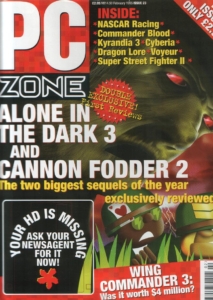
Two ratings for Wing Commander 3 in this issue, depending on the processing power of the PC it was played on. Also: one (scandalously high) mark for Rise of the Robots.
But was the PC Zone verdict one that could be relied on? It could be argued that the reason people buy games magazines is to find out whether new releases are any good, and hence the barometer of a decent one should be how accurate its reviews are. Frankly, though, the obsession with “accuracy” in reviews is ridiculous, and one peculiar to the world of gaming – possibly deriving from the fact that they’re nearly always given a percentage score, leading to preposterous discussions on letters pages about whether Quake II should have been given 97% or 95%. Zone gave its readers the usual spiel about only reviewing finished games, not caving into publisher pressure and giving ‘Classic’ ratings only to games that deserved it – and it did just about as well as any other magazine at dishing out good marks to genuinely remarkable titles. However much importance people might attach to ratings, there’s nothing particularly memorable about a bunch of numbers at the bottom of a page and it was the quality of the writing which, more than anything, made PC Zone stand out from the rest.
Though Zone is still going strong today, the quirky charm it once had seems to be missing, with the appearance and editorial style gradually moving towards that of rival magazines. With publishing rights recently acquired by the behemoth that is Future Publishing, the current incarnation of Zone bears a remarkable resemblance to Future’s flagship PC games magazine (and long-time rival), PC G*m*r, and it seems only a matter of time before the two are merged in some way. Though some may claim that the spirit of the original magazine died some time ago, and it’s certainly had a good run, it would nevertheless be sad to see it go. Whatever odd combination of factors contrived to see this website established, it’s safe to say that growing up reading PC Zone was one of them.

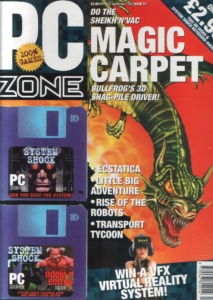
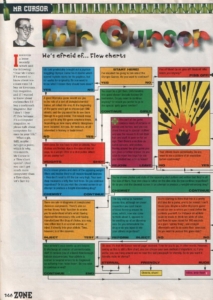
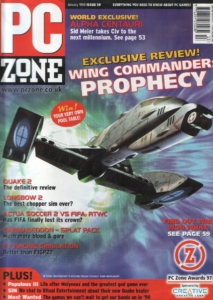
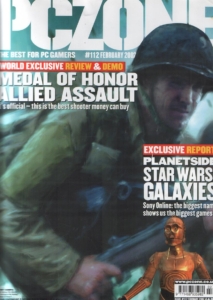

 Posts
Posts